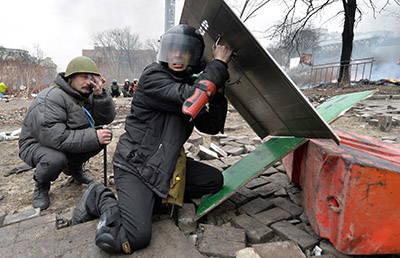Covering street violence is one thing. Covering gunfire is another. This week, firearms were unexpectedly introduced into ongoing clashes between protesters and police in two parts of the world, raising the threat level faced by journalists trying to cover events.
At least one journalist in Venezuela was injured by gunfire. Mayra Cienfuegos of the state television network VTV was shot while covering protests around the network’s headquarters. The state network blamed the gunfire on opposition protesters. The use of the firearms came after government security officers and pro-government crowds physically assaulted at least 13 journalists, according to the local free expression group Espacio Público. Police also detained at least six journalists.
Even more lethal force was introduced in the Ukraine, when snipers began opening fire with rifles against protesters either advancing or gathering near police lines. At least 20 protesters have been killed. According to the Los Angeles Times, some of the bullets removed from the victims were 7.62mm in diameter, suggesting that a high-powered rifle like a Soviet-era Dragunov sniper rifle was in use by snipers.
So far, there are no reports of journalists being hit by sniper fire. Earlier this week, however, two journalists were attacked by masked men wielding bats, firebombs, and guns. One of the attacked journalists, Vyacheslav Veremiy, was shot in the chest and later died of his wounds. Dozens of journalists have been injured in Kiev and other cities covering the protests.
Journalists covering events in either Venezuela or the Ukraine should consider wearing and obtaining body armor. But the body armor or “bulletproof” vest should also match the known threat level in each nation. Body armor is rated worldwide according to the U.S. National Institute of Justice rating system. Level II body armor vests are designed to protect against most handguns, including 9mm and up to a .357 Magnum pistol or revolver. This might be sufficient for covering violent protests in Venezuela, where handguns have been the main firearms used so far.
But it would be insufficient now for the Ukraine, where military rifles are in use. In Kiev and other cities, body armor rated up to at least a Level IIIa would be recommended, as it is designed to protect against more powerful weapons and still be worn underneath clothing. But donning a Level III body armor would be better, as only a Level III vest, which is the lowest level of protection recommended for most military situations, will stop bullets from the kind of high-powered rifles in use in the Ukraine.
CPJ’s Journalist Security Guide provides more discussion about body armor. Journalists must be informed to make their choices wisely.
